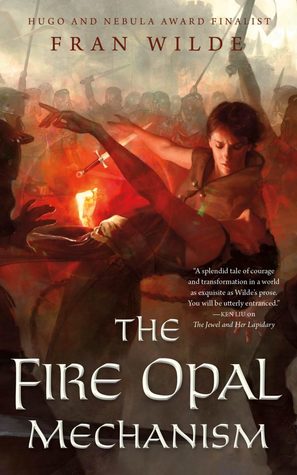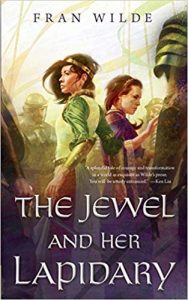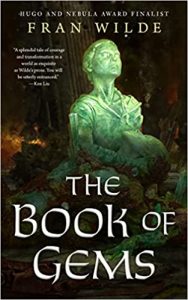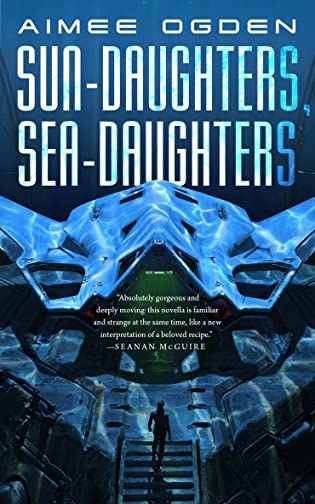 Time's Agent by Brenda Peynado
Time's Agent by Brenda Peynado Format: eARC
Source: supplied by publisher via Edelweiss
Formats available: paperback, ebook
Genres: climate fiction, science fiction, time travel
Pages: 160
Published by Tordotcom, Tordotcom Publishing on August 13, 2024
Purchasing Info: Author's Website, Publisher's Website, Amazon, Barnes & Noble, Kobo, Bookshop.org, Better World Books
Goodreads
“What would you do, given another universe, a do-over?”
Forty years ago, archeologist Raquel and her biologist wife Marlena once dreamed of the mysteries they would unlock in their respective fields using pocket universes— geographically small, hidden offshoots of reality, each with its own fast or slow time dilation relative to Earth time—and the future they would open up for their daughter.
But that was then.
Forty years later, Raquel is in disgrace, Marlena lives in a pocket universe Raquel wears around her neck and no longer speaks to her, what’s left of their daughter’s consciousness resides in a robotic dog, and time is a commodity controlled by corporations squeezing out every last penny they can.
So when a new pocket universe appears, one that might hold the key to her failed calling, Raquel seizes one last chance to redeem herself to her wife, live up to her own failed ideals, and confront what it means to save something—or someone—from time.
My Review:
On the one hand, Time’s Agent is a familiar story about human greed and corporate rapaciousness, set in a near-future version of our world where climate change is proceeding apace, badly and past the point of no return, and the resulting dystopian society is running amuck right along with it.
And on the other hand, the way it tells that familiar story is through messing with time – even though Time’s Agent is explicitly not a time travel story – at least not unless Rip van Winkle’s story is a time travel story. Instead, this is a story about the “true” theory of the relativity of time. Not Einstein’s version, but rather Zall’s Second Law, the one that goes, “How long a minute is, depends on which side of the bathroom door you’re on.”
The so-called “pocket worlds” that are discovered, explored and protected by their Institute represent vast, exploitable resources to the megacorporations that are well on their way to taking over the world. Some PW’s are fast relative to Earth standard time, and some are slow, and there are ways to monetize and use them up.
The Institute stands in the way of all that, at least until Raquel makes a terrible mistake and accidentally falls into a fast-time PW that spits her out forty Earth standard years later. Her disappearance – along with the disappearance of her wife who was inhabiting a slow-time PW around Raquel’s neck – turned out to be the catalyst for terrible changes, both for them personally and for the world in general.
Like Rip van Winkle, the place that Raquel and Marlena return to is nearly unrecognizable to the two “time travelers”. In the 40 years that they missed, their daughter died, their Institute was gutted, corporates control EVERYTHING, and the World War III that occurred in the interim pushed the entire Earth further and faster down the road to destruction.
The only hope that Earth has is to find a pocket world that is much more than a pocket. A world that is big enough to start both species and civilization over again. Raquel and Marlena’s only hope is to get there first and close the door behind them.
Escape Rating A-: Time’s Agent is a story where the whole is definitely greater than the sum of its parts, but the parts are what we have in our hands to read. In other words, this is a mixed feelings kind of review because well, my feelings about the whole thing are mixed.
What adds to my extreme mixed feelings is that the overall feeling of the story is profound grief. Forty years into a terrible future, Raquel is grieving pretty much everything, her marriage is fractured, their daughter is dead, her friends are scattered, her once-shining hopes have fallen into disillusionment, the Institute she believed was both her family and her calling has been suborned and her world is dying.
Raquel’s grief permeates the entire story, to the point where she’s justifiably wallowing for much of its length – and the story wallows with it. It makes sense from her equal parts depressed and horrified perspective but it makes for a difficult and sometimes low, slow and even ponderous read as she tries to get her shit together in a world where she doesn’t know if the place she left it last still exists.
The SFnal parts of this one reminded me of a whole bunch of things, not all of which are themselves SF. The combination of the way that the pocket worlds work, that you can go in to a slow time PW, stay a long time and come out at the same minute you left, physically unchanged but mentally quite different echoes the Star Trek Next Generation episode The Inner Light, while the differences caused by Raquel and Marlena’s absence from the world and the way in which that absence occurred recalled Yesterday’s Enterprise and the profound changes wrought by the Enterprise C’s presence or lack thereof at Khitomer.
The exploitation of both the pocket worlds and the people who used and abused those worlds and/or were abused by them calls to mind Charlie Stross’ Merchant Princes series and especially Kage Baker’s books about the rapacious, time-traveling and looting Company. Consider all of the above readalikes or watchalikes for Time’s Agent, albeit in different ways.
One of the fascinating things about this story, and that puts it over the hump from B+ to A-, is the way that the story is both set in and steeped in the author’s Dominican culture, and the way that the setting emphasizes the evils AND the pervasiveness of both colonization and colonialism, using that setting to point out that the fate of the pocket worlds and THEIR exploitation has all happened before, is happening now, and will all happen again. At the same time, the characters’ perspectives on their world before Raquel’s fall into fast time and her return provides a fascinating contrast by showing both Raquel and the reader just how easy it was for her to ignore the already worsening state of the world as a whole as long as her personal little corner of it was doing just fine.
And at the same time, while I don’t want to call this a solution because it isn’t a solution overall but is one for Raquel and Marlena, is rooted in the nearly forgotten and utterly subjugated history of their own people, and it’s answer that could only have come from the survivors of colonization and not its perpetrators, and that is utterly right and woven into this story from the outset.
In the end, I still have, as I said, some mixed feelings about this one. Admittedly, my most mixed feeling is that this would have been better at a longer length, with a bit more of Raquel’s and, as it turns out, Marlena’s, planning made a bit more manifest a bit earlier on. Because there’s a lot to unpack in this story and this reader at least ended up relying on resemblances to the above readalikes/watchalikes to vault over some of those hidden bits, as well as using those vaults to carry me past the depths of the protagonist’s wallow.
All of that being said, this is the author’s DEBUT novel. Considering that this is her first novel, the number of wild but mostly realized ideas combined with the heartbreaking poignancy of the portrayal of the protagonist’s grief and desperation have absolutely put this author on my reading radar and I can’t wait to see what she comes up with next!

 The Fire Opal Mechanism (Gem Universe #2) by
The Fire Opal Mechanism (Gem Universe #2) by  Escape Rating A-: At first, and for a rather long time thereafter, it seems as if the core of The Fire Opal Mechanism is about the freedom of information versus the censorship of it. And yet, at the beginning – the beginning that Ania and Jorit observe and not the place where they personally start – that wasn’t actually the case.
Escape Rating A-: At first, and for a rather long time thereafter, it seems as if the core of The Fire Opal Mechanism is about the freedom of information versus the censorship of it. And yet, at the beginning – the beginning that Ania and Jorit observe and not the place where they personally start – that wasn’t actually the case. That their harrowing journey together bonds Ania and Jorit in their own mutual truth is the sparkling icing on a very tasty and thought-provoking little book-cake.
That their harrowing journey together bonds Ania and Jorit in their own mutual truth is the sparkling icing on a very tasty and thought-provoking little book-cake. Sun-Daughters, Sea-Daughters by
Sun-Daughters, Sea-Daughters by